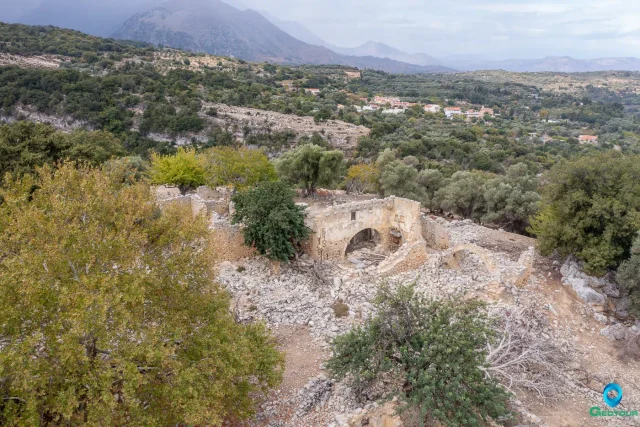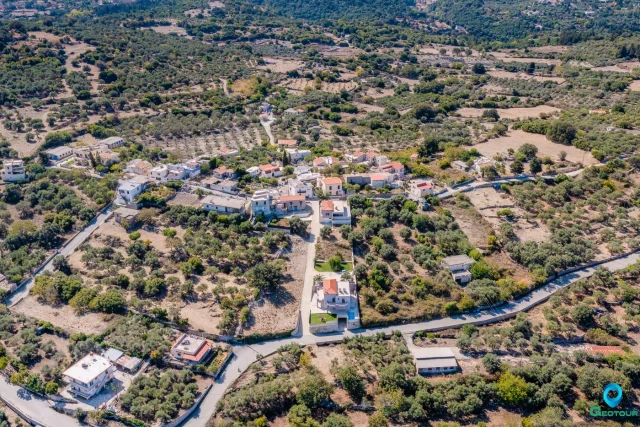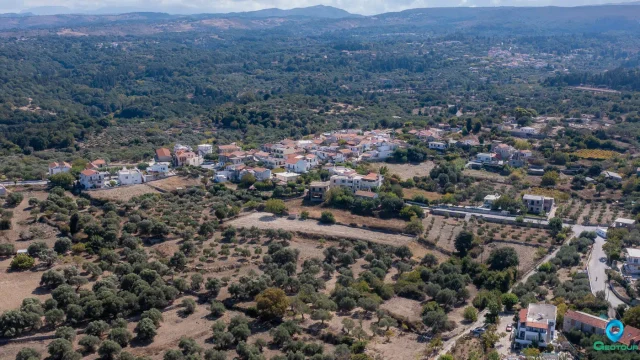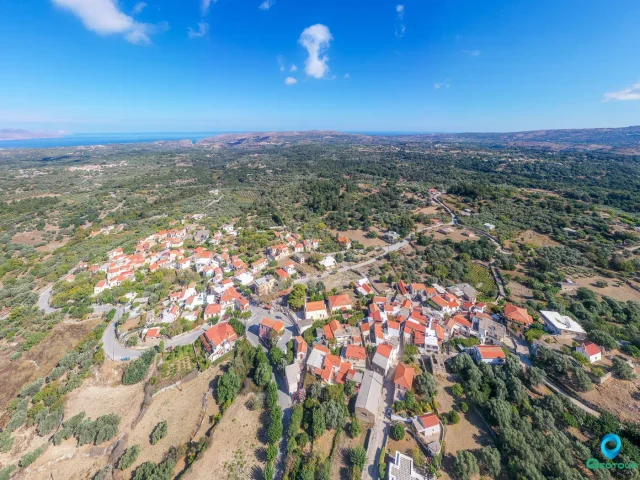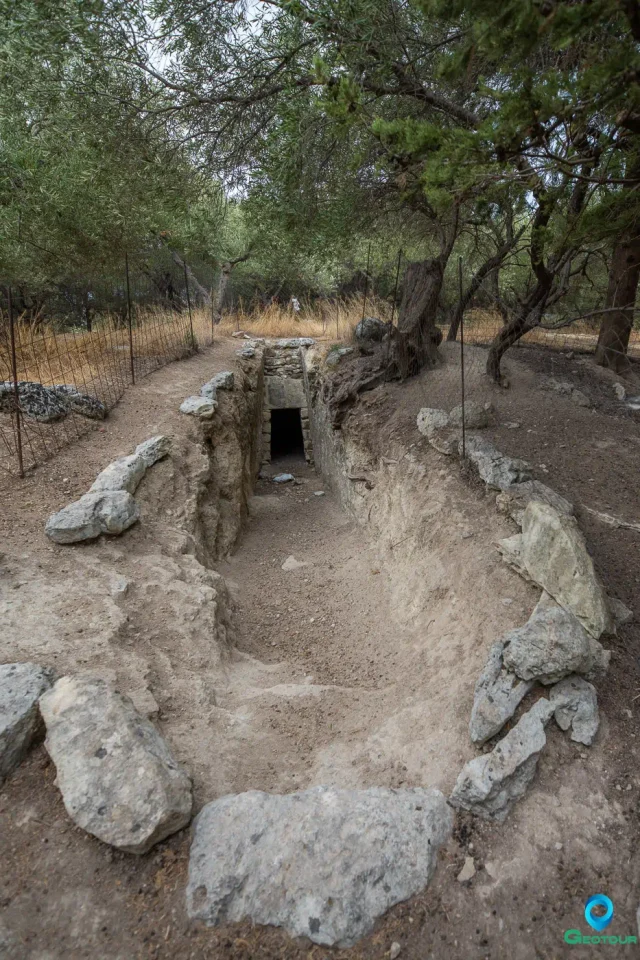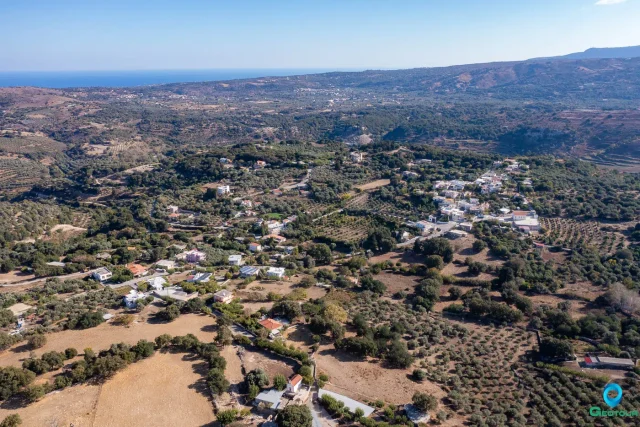Argyroupoli (Greek: Αργυρούπολη) is a village and the seat of the homonymous community within the Municipality of Rethymno in the Regional Unit of Rethymno, Crete, Greece. From 1999 to 2010, under the previous administrative division of Greece, it was the seat of the homonymous municipal department of the Municipality of Lappaion. The village is situated at an approximate altitude of 260 meters. It has been designated a traditional settlement of medium cultural value (category II) (Government Gazette 728/1995). In 2008, it received an award for the “cleanest organized traditional settlement” from the Prefectural Committee for Tourism Promotion of Rethymno.
The village is built on the site of the ancient city of Lappa.
Name
The ancient city was known as Lappa (Ancient Greek: Λάππα). Alternative spellings found in ancient sources include Lampa (Λάμπα), Lampae or Lampai (Λάμπαι), or Lampe (Λάμπη). On coins, the name is consistently rendered as Λάππα. Stephanus of Byzantium asserts that these names refer to the same location. During the Middle Ages, its name changed to Stimpolis, derived from the phrase “stin poli” (meaning “in the city”). Later, it was known simply as Polis. It acquired its current name, Argyroupoli, in the 19th century.
History
Ancient Lappa
According to a mythic tradition reported by Stephanus of Byzantium, the city was founded by Agamemnon and named after a Tarrhaean man. Strabo indicates that Lappa controlled the port of Phoenix.
Lappa is mentioned in various ancient sources, including accounts of the Lyttian War (220 BCE) and the First Cretan War (205 BCE to 200 BCE). Polybius notes that Lappa offered refuge to the people of Lyktos after Knossos destroyed their city. Dio Cassius records that Lappa was almost completely destroyed by the Romans during their conquest of Crete. However, it was later rebuilt by Octavian Augustus, who granted it special privileges, including the right to mint its own currency, because its inhabitants had supported him in his conflict with Mark Antony. Coins minted by Lappa featured the heads of emperors, including Augustus, with one such coin bearing the epigraph ΘΕΩΚΑΙΣΑΝΙ ΣΕΒΑΣΤΩ. Lappan coins also displayed maritime symbols, possibly reflecting the city’s coastal territories.
Lappa became a Christian episcopal see. The name of its bishop is recorded as being present at the Council of Ephesus in 431 CE and the Council of Chalcedon in 451 CE, as well as on numerous subsequent occasions.
In the 19th century, English traveler Robert Pashley visited the site. He reported observing substantial remains of a massive brick edifice with buttresses 15 feet wide and projecting 9 feet, a circular building 60 feet in diameter with niches 11 feet wide, a cistern measuring 76 by 20 feet, a Roman brick building, and several rock-cut tombs. An inscription found relating to the city mentions a Marcus Aurelius Clesippus, in whose honor the Lappaeans erected a statue.
Later History
In September 1930, a failed one-day movement led by Dr. Iosif Sfakianakis erupted in Argyroupoli.
Attractions
The village and its surroundings contain numerous traces of ancient and more recent civilizations. Excavated sections of the ancient city, Roman remnants, Venetian buildings with elaborate doorways, and Byzantine churches can be found both within and around Argyroupoli.
A notable attraction is a mosaic from the Roman period. Near the village, visitors can explore an ancient necropolis and see a plane tree that is several centuries old. The area is also known for its beautiful water springs and old mills.
The area is renowned for the springs of Agia Dynami (Holy Power), a lush area where water flows from various points. Here, visitors can rest at one of the taverns that cater to tourists. The waters from the Agia Dynami cave, after passing through old watermills that once ground grain, flow into the Mouselas River. These watermills have now been converted into taverns serving traditional food.
Churches
The main church of the village is dedicated to the Taxiarches (Archangels). Ecclesiastically, it belongs to the 5th Archiepiscopal Region of the Holy Metropolis of Rethymno and Avlopotamos, of the Church of Crete.
Other churches in and around Argyroupoli include:
- The Church of Pente Parthenes (Five Virgins): Located outside the village, this small, rectangular church is partially carved into the natural rock. It is one of the most significant pilgrimages in western Crete.
- Panagia (Virgin Mary): Also known as Panagia Barotsi, after the Barotsi family who built it. It is a double-nave church with naves of different lengths, a narthex for both, and traces of frescoes.
- Agios Ioannis (Saint John): A small church carved into the rock at the springs of Agia Dynami.
- Agia Kyriaki (Saint Kyriaki): A small church with remnants of frescoes, which also incorporated part of a brick-built Roman building.
- Agios Nikolaos (Saint Nicholas): Located outside the village, with remnants of 13 frescoes.
Culture and Traditions
The Church of Pente Parthenes (Five Virgins), which celebrates on Easter Tuesday, holds a significant place in local tradition. According to local lore, five young women from Argyroupoli or a nearby town sought refuge and a life of asceticism in the carved tombs of an ancient cemetery. They lived, died, and were buried there in old tombs. During their lives, they gained great renown, and many pilgrims came to the caves seeking their blessing. The site remained sacred after their deaths, as holy water (agiasma) began to flow from their tombs.
On Easter Tuesday, a large festival takes place in Argyroupoli. Many faithful attend to collect holy water from the tombs, considering it a blessing and a cure. They keep it in their iconostasis and drink it while fasting on important days of the year. Older people traditionally sprinkle a few drops of this holy water in the four corners of their homes or on newly planted summer gardens to ensure an abundant harvest. The soil from their tomb is also considered to have healing properties; people scrape it and rub it on warts, believing they will disappear within a few days. On the same day, a blessing of the sheep occurs, and milk is boiled and offered after the church service.
Administrative Information
Argyroupoli was officially recognized as a settlement in 1925 (Government Gazette 27A – 31/01/1925) and designated as the seat of the newly established community of the same name. According to the Kallikratis and Kleisthenis I programs, it constitutes the community of Argyroupoli, which belongs to the municipal unit of Lappaion of the municipality of Rethymno.
The Argyroupoli area was included in the Rethymno Land Registry Office (Ktimatologiko Grafio Rethymnou) on March 28, 2005. The office is located at Chortatzi 20, Rethymno.
Notable People from Argyroupoli
- Ilias Deligiannakis: Chieftain, Member of Parliament for Rethymno.
- Stylianos Kasotakis: Plenipotentiary of Rethymno, fighter, Mayor of Lappaion.
- Stelios Kiagiadakis (1955-2020): President of the Vrakoforon Club of Crete.
- Michail Papamichelakis: Member of Parliament for Rethymno.
- Alexandros Tsirintanis: Professor of Law at the University of Athens.
Settlement: Key Points
- Historical References: Site of the ancient city of Lappa. Mentioned in accounts of the Lyttian War (220 BC) and the First Cretan War (205-200 BCE). Rebuilt by Octavian Augustus. Became a Christian episcopal see by the 5th century CE.
- Location: Municipality of Rethymno, Crete, Greece. Situated at an altitude of approximately 260 meters above the Mouselas river valley.
- Historical Significance: Important Roman city with the right to mint its own currency. Contains Roman remains, Venetian architecture, and Byzantine churches.
- Current Status: Designated traditional settlement. Seat of the community of Argyroupoli. Awarded for being the “cleanest organized traditional settlement” in 2008.
- Population Data:
Year | Population | Notes |
1583 | ||
1881 | 730 | 730 Christians |
1900 | 851 | |
1920 | 760 | |
1928 | 767 | |
1940 | 836 | |
1951 | 704 | |
1961 | 669 | |
1971 | 501 | |
1981 | 453 | |
1991 | 396 | |
2001 | 402 | |
2011 | 403 | |
2021 | 313 | Official census registration |















